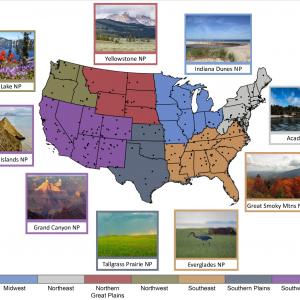New Publication on Climate Change Adaptation in National Parks
Date
In the new paper, “Drought and deluge—opportunities for climate‐change adaptation in US national parks,” Meagan Oldfather, NC CASC/USGS climate change adaptation specialist, and other NC CASC/USGS colleagues assess future climate exposure across 332 U.S. national park units using 40 downscaled projections of five key climate variables: mean annual temperature, mean annual precipitation, frequency of extreme precipitation events, growing-season length, and annual climatic water deficit (CWD). The study quantifies both the magnitude of projected mid-century climate change and the associated uncertainty within each park and region, revealing broad trends of increasing temperatures, longer growing seasons, more frequent precipitation extremes, and worsening drought stress. While temperature projections show consistent warming across all regions, precipitation projections were highly uncertain, especially in the Southwest, posing distinct challenges for adaptation planning.
By translating climate projections into standardized z-scores (differences between projected future and historical means, relative to the historical standard deviation) and analyzing results by U.S. National Climate Assessment regions, the authors highlight where scenario-based planning can be streamlined, shared across similar parks, or tailored for outliers. Importantly, they identify that some parks may need to prepare for both flooding and drought simultaneously, despite these appearing to be contradictory conditions. The study underscores how embracing uncertainty, rather than avoiding it, in climate projections can improve climate adaptation strategies across the National Park System. It also calls for continued integration of ecological responses and fine-scale park characteristics into future planning to better address the complexities of conservation in a rapidly changing climate.


